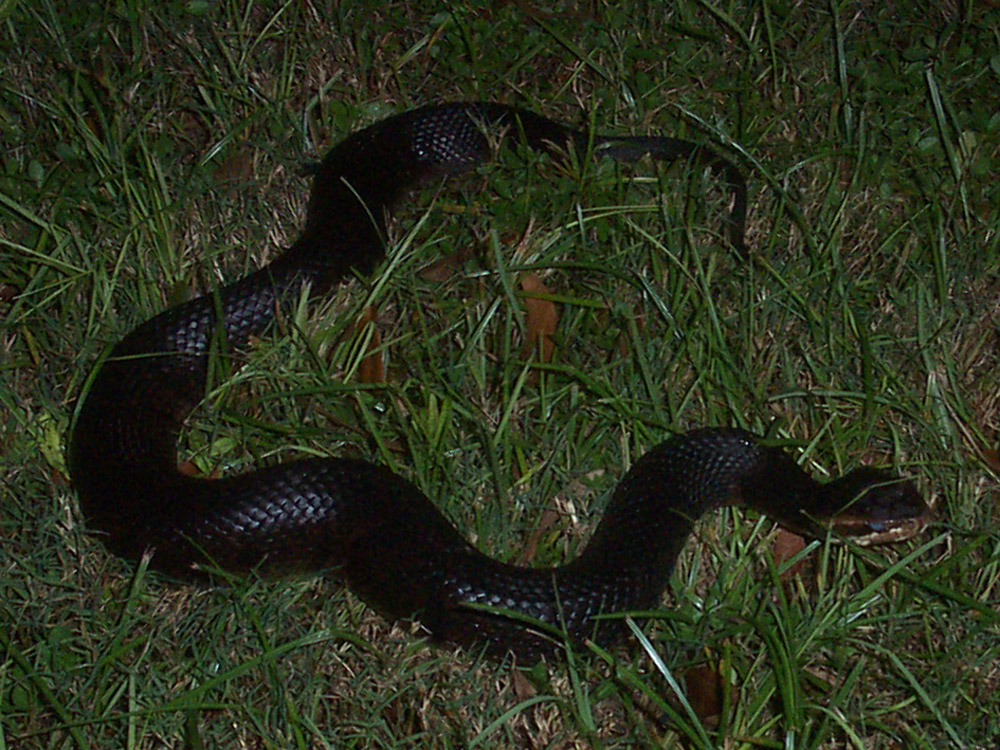|

 |
The Cottonmouth / Water Moccassin also has a very venomous bite. |
 |
DESCRIPTION: Adult Water
Moccasins are nearly totally black - but they are also fat, which
differentiates them from harmless black snakes.
If you need snake removal in your town, click for the National Directory of
Snake Removal Companies that I've carefully compiled in every USA city.
Large Cottonmouth snakes are venomous snakes that are often referred to as water moccasins. They have heads that are large and triangular in shape with a dark line through their eye. Their venom glands cause them to have large jowls. They usually reach 24 to 48 inches in length.
Their coloration varies from snake to snake. They have beautiful markings with dark crossbands on a brown yellow ground color or are completely brown or black. The cottonmouth snake can be found near all freshwater habitats but are usually found more commonly in swamps and wetlands that are heavily vegetated. They are found throughout the southeast and north to southeastern Virginia.
The activity level of the cottonmouth snake usually occurs at night, and then they bask in the sunlight during the day. Because the Cottonmouth spends so much time in the water, they need to bask in the sun to keep their high body temperature raised. These snakes prefer to bask on thick logs or warm rocks. The water causes their temperature to quickly drop which is dangerous to the health of the snake.
Cottonmouth snakes vary in their temperaments. They are generally not an aggressive reptile and will usually only attack if they become agitated or feel threatened.
Cottonmouths carry their babies until they hatch. While most snakes will lay their eggs to hatch at a later date, a cottonmouth has an embryo egg and carries the eggs in their body until they hatch. This causes them to give birth to a live newborn cottonmouth. Newborn Cottonmouth snakes have a very unique technique for capturing their prey compared to other snakes. Their brightly colored tail appears similar to a snake. They flick the tip of their tail near minnows and small frogs to attract them into a distance where they are able to attack.
Running a wildlife removal business in the state of Florida gives me the chance to see all kinds of interesting snakes! Florida has about 45 species of snake, and I've seen 29 of them so far. I've always got my eye out for new species, and
I love spotting rare snakes in Florida. I also have a thing for venomous snakes - they're not too common in FL, so I always enjoy the chance to see a poisonous serpent. I really like snakes, and I've never hurt or killed one. They're an
important part of the ecosystem, and often persecuted. Still, if you don't want snakes in your house or on your property, and judging from the number of phone calls I receive regarding snake problems, you don't, then give me or a local snake
expert in your area a call, and we can remove the snakes from your property for you. I use many snake control methods - from snake traps, to snake repellents, to habitat modification, but most of all, good old-fashioned capture and removal.
If you want to learn more, please read my How To Get Rid of Snakes page.
AAAnimal Control is a privately owned wildlife removal and pest control business, located in Orlando Florida. I deal strictly with wild animals including snakes inside houses. I am not an extermination company, but a critter removal
and control specialist. The above photos are some of the many that I've taken in the field over my years of work. Please email me if
you have any questions about the above photographs, or any questions about
wildlife problems or Florida snake removal issues.
You can safely catch snakes with a special trap, which you can order by clicking this banner:

|
| |
|